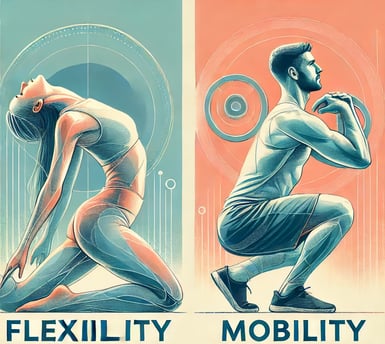Flexibility vs. Mobility: What’s Best for Your Fitness Routine?
Naseeb Khan
5/25/20242 min read


In the world of fitness, the terms "flexibility" and "mobility" often pop up, sparking debates among trainers, movement experts, and fitness enthusiasts. Some argue that we should steer clear of traditional stretching in favor of mobility exercises that increase active control over a joint’s range of motion. So, who’s right? Let's dive into what each approach offers and how to find the best balance for your goals.
Flexibility vs. Mobility: What’s the Difference?
Flexibility is the ability of muscles and tissues to stretch. It's typically improved through passive stretching, where a joint is moved to its end range with the help of external force (think of bending forward to touch your toes). Flexibility exercises are popular for their feel-good factor and relaxation benefits, especially when paired with breathing exercises at the end of a workout. However, some research suggests that too much passive flexibility, without the strength to support it, might increase the risk of injury.
Mobility, on the other hand, is about having active control over a joint’s range of motion. Mobility exercises aim to build strength and stability within the range you can control—essentially the functional movement that allows you to move more freely and with greater control. Think of it as flexibility you can use; for instance, the ability to squat deeply while maintaining control over your balance and body alignment.
Which Is Better for Injury Prevention?
Movement experts often emphasize mobility over passive flexibility for one key reason: injury prevention. Joints that are overly flexible without adequate support can be prone to strains and instability. This is especially relevant for athletes or those engaging in high-intensity activities where sudden shifts in movement or load-bearing are common. For clients who participate in sports or activities that demand agility and strength, mobility exercises are essential for enhancing control and resilience under pressure.
However, it’s essential not to dismiss passive flexibility entirely. For many clients, stretching offers a valuable mental and physical cooldown, helping ease tension and encourage relaxation after workouts. When done mindfully, stretching can provide relief and a sense of accomplishment as they ease into deeper ranges of motion over time.
Finding the Right Balance for You
So, do you need to abandon your stretches in favor of mobility drills? Not at all. Both flexibility and mobility have a place in a well-rounded fitness routine. The key is to assess your personal goals and physical needs:
High-Intensity Athletes (e.g., powerlifters, sprinters): Prioritize mobility to build strong, stable joints.
Clients Seeking Relaxation (e.g., yoga enthusiasts, desk workers): Include passive flexibility for relaxation but incorporate mobility to maintain joint health.
Everyday Fitness Seekers: Balance both. Use flexibility for recovery and relaxation, and mobility for control and function.
The Verdict
Ultimately, the best approach is a client-specific blend of flexibility and mobility. Focus on your goals, enjoy the benefits of both approaches, and tailor your routine to what feels best for you. Passive stretching can still be a great tool to transition out of a workout and bring you back to daily life, while mobility ensures you stay strong and capable in every range of motion.
Bottom Line: There’s no “one-size-fits-all” answer. A blend of flexibility and mobility, personalized to your body’s needs and preferences, is your best route to achieving a balanced, injury-free fitness journey.



